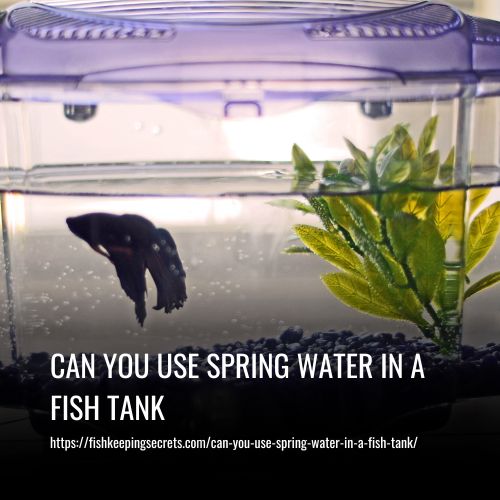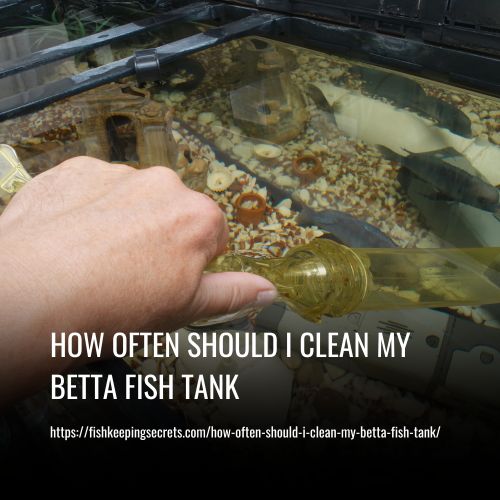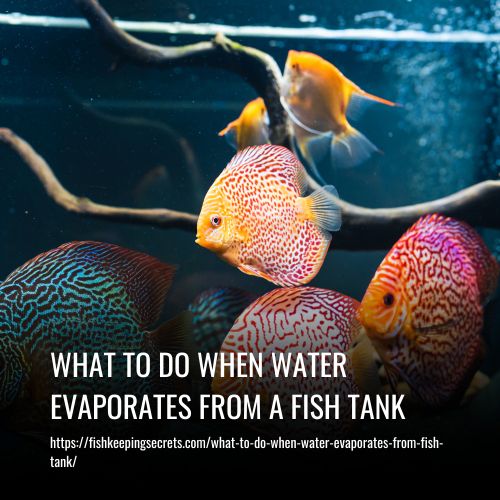Spring water can be used in a fish tank as long as it is free from contaminants and has been properly treated to remove any harmful substances. It is important to test the water for pH, hardness, and any other parameters to ensure it is suitable for the specific type of fish you are keeping.

Using Spring Water for Fish Tanks
Spring water has long been thought to be a safe and reliable source of water for fish tanks. However, not all spring water is equal – many brands of bottled spring water on the market have been found to be highly contaminated and acidic in pH.
As such, it is important to research different brands before using them, checking the mineral content and pH level to determine if they are suitable for use in aquariums. Additionally, spring water can often be more expensive than tap water, making it a less viable option for larger aquariums.
The primary benefit of spring water over other sources is that it usually does not contain chlorine or heavy metals. While testing for mineral content and pH levels before use is essential, adjusting levels with pH up or down treatments can also help create an optimal environment for your fish.
Is Spring Water More Acidic?
When setting up an aquarium, some experts recommend using spring water as a way to maintain healthy levels of alkalinity. However, it is important to note that spring water can both have acidic and alkaline qualities, depending on where it comes from. Additionally, bottled spring water tends to be more acidic than other types of water and thus is not suitable for freshwater fish.
When adding spring water to an existing tank, it is essential to test and treat the new water before introducing any fish. Extremely acidic water can be toxic to fish and cause potential illness or death. If your aquarium becomes too alkaline, you may want to consider using more acidity-balanced spring water as a way to regulate PH levels.
What Are the Benefits of Using Spring Water in Fish Tank?
Utilizing spring water in a fish tank may offer certain benefits.
1. High Oxygen Content:
Aquariums require oxygen in order to sustain the life of their inhabitants. It is important to ensure that your fish tank has enough oxygen for your fish. Spring water is known to have higher levels of oxygen compared to other kinds of water and may be ideal for providing the necessary levels of oxygenation required by a fish tank. It’s important to keep an eye on the oxygen level within your tank, as too little can cause stress, illness, and even death in fish.
Additionally, it’s always recommended to filter and aerate tanks regularly to maintain good water quality and ensure adequate oxygen circulation in the tank.
2. Keeps Your Fish More Active:
Spring water is special because of its unique levitational quality which is caused by the molecular arrangement of hydrogen oxide. This levitational quality allows your fish to swim without being subject to pressure from the water, resulting in more active and vigorous swimming.
Additionally, spring water has no pollutants and fewer contaminants than tap water, making it a healthier choice for your fish tank.
3. Provides Nourishment:
Springwater is an excellent choice for fish tanks, as it contains all the essential elements needed for healthy aquatic life. It is packed with minerals, nutrients, and prebiotics to provide nourishment to your fish.
Additionally, springwater has a balanced pH level and is free of pollutants and other contaminants, making it much safer than tap water. To ensure the optimal health of your fish, conduct regular water tests in order to monitor water quality levels.
Can You Use Spring Water In A Fish Tank? 6 Reasons You Can’t!
Yes, you can use spring water in a fish tank, especially if you are using it to water your plants or when making small water changes. Spring water is generally high in minerals and can impart beneficial nutrients to some aquatic plants. However, it is not recommended to use spring water for your entire aquarium as it may contain too many minerals that can affect the pH balance of the tank.
Additionally, most spring waters contain chlorine which is toxic to fish and must be removed before use. It is important to ensure that the spring water being used does not contain any contaminants or additives such as fertilizers or herbicides as these can be harmful to fish and other aquatic creatures.
Therefore, it is best to only use spring water in moderation and perform regular tests on the quality of the water to make sure it remains safe for your fish.
Can You Use Spring Water In A Fish Tank?
Using spring water in a fish tank can be risky because the mineral content and pH levels will vary depending on where its sourced. Additionally, the mineral content can vary greatly from brand to brand, making it hard to find a suitable match for your fish’s needs without extensive testing. Furthermore, there is always the possibility that you may use an incorrect or unstable mixture which could affect your fish’s health.
Therefore, it is important to research and evaluates each type of spring water before introducing it into your tank. It is also advisable to test the water for key parameters such as pH, gH, and kH before use. Ultimately, using spring water in your aquarium comes with some risks and should be done with caution.
Reasons Why Spring Water Is Not Suitable For Fish Tanks
It is generally not advisable to use untreated spring water in a fish tank due to the potential contaminants and lack of beneficial minerals that can be present. Spring water may often be infected with bacteria and viruses, as well as heavy levels of pesticides, industrial chemicals, and drilling compounds.
Additionally, spring water may have a high acidic value which can burn the skin of your fish and potentially prove deadly. Due to its pH value and mineral content varies from region to region, it can also cause instability in your tank’s chemistry that could endanger your fish.
Finally, spring water may be treated with chlorine which is highly toxic to fish and can damage their sensitive gills as well as cause respiratory illnesses. Ultimately, while opinions vary among aquarium hobbyists, it is generally safest to avoid using untreated spring water in your fish tank.
Do You Need to Condition Spring Water for Fish?
Yes, if you decide to use spring water in your fish tank, you must always test and condition it first. Test the water for its pH and hardness to make sure that these parameters are correct. Once they have been verified, you can use a water conditioner to neutralize chlorine and other chemicals.
Never put any water in your fish tank before testing and conditioning it, with the exception of pre-conditioned water made specifically for your aquarium. It’s important to take the necessary precautions to ensure that your fish stay healthy and happy.
How To Use Spring Water in a Fish Tank
When setting up a fish tank, it’s important to make sure that the water you use is properly conditioned. This involves adjusting the pH, alkalinity, and other aspects of the water in order to make it suitable for fish. If you are using spring water in your tank, it is important to make sure that the water parameters are stable.
Springwater already contains many essential minerals and nutrients, so there is no need to add any additional chemicals to your aquarium. It is recommended that you use a general water conditioner or purifier in order to remove any excess chlorine or chloramine from the water.
Additionally, regular testing of your aquarium’s water quality can help ensure that your fish remain healthy and happy.
Why Does Spring Water Need to be Treated?
Spring water has many benefits when used in a fish tank. Specifically, it is rich in minerals, such as potassium, calcium, sodium, and magnesium, which can be beneficial to the overall health of the fish.
Additionally, because spring water comes from an underground source and passes over rocks that contain various minerals and elements along its journey, each spring has a unique composition.
However, spring water can also be affected by other environmental factors such as pollution or hard water. Therefore, you should always treat any spring water you plan to use in your fish tank before adding it to ensure that it is safe for your fish.
You can do this by using a de-chlorinator to remove any unwanted compounds or by running the water through an aquarium filter for several hours before introducing it into the tank.
How to Treat Spring Water for Aquariums
As an aquarium enthusiast, it is important to consider several factors when preparing your fish tank. It is essential to treat the water before introducing any fish and make sure it is safe for them by testing the pH, hardness, carbonate, and bicarbonate levels. Knowing in advance what type of fish you plan to put in the tank can help determine the desired pH level.
If the pH levels are too high or too low, there are a few ways to adjust it including chemical treatments and natural wood tannins. Additionally, purifying spring water with a reverse osmosis filtration system will help reduce heavy metals that could be harmful to your fish.
Finally, using a water conditioner will help make your aquarium more comfortable for your new aquatic friends and make their transition to their new home smoother.
Ultimately, doing research and taking precautionary steps before introducing any fish into their new environment will ensure your success as an aquarium enthusiast!
FAQs
No, well water is not recommended for use in fish tanks as it can contain a high amount of minerals and other contaminants. Additionally, the pH level of well water is often a challenge to keep stable, making it difficult to replicate desired conditions for healthy fish and plants.
Treating well water for aquarium use should include testing, aeration, and the addition of a de-chlorinator. Additionally, depending on the levels of minerals, buffers, and other substances found in your well water you may need to adjust pH or add additional mineral supplements.
Many types of fish can live in tap water, including species such as guppies, goldfish, tetras, bettas, and mollies. Before putting these fish in the tank it is important to make sure the chlorine is filtered out first. This can be done by allowing the water to sit for at least 24 hours or using a water conditioner specifically designed for aquariums.
Fish can survive in tap water for a few hours, however, it’s not recommended and should be avoided as much as possible due to the pollutants and other toxins that might be present in tap water. The safest way to introduce fish into a tank is to use water conditioned with a de-chlorinator, such as Seachem Prime.
The pH level of tap water usually ranges from 6.5 to 8.5.
The most important thing for keeping your fish tank clean and healthy is to use water that has been treated with a de-chlorinator. Purified water, spring water, and tap water should all be treated with a de-chlorinator before being added to the tank. Keeping up with regular partial water changes will also help keep your fish’s habitat safe and healthy.
No, spring water does not inherently kill fish in a fish tank. Provided that the temperature of the spring water is similar to the current tank water, and it has been bacteria tested, it can be used safely.
However, before using any new source of water for a fish tank, it is essential to check its chemistry to ensure it is safe for aquatic life.
Distilled Water is better for fish tanks, as distilled water does not contain any minerals which could potentially upset the valuable balance of your tank, whereas spring water contains minerals naturally found in the source such as calcium, sodium, and magnesium, and excess amounts of them could adversely affect fish health.
No, it is not recommended to use bottled spring water for fish tanks. Bottled spring water often contains minerals that are not ideal for fish tank systems and can create an imbalance in the water chemistry. It can also be more expensive than tap water or other sources of fresh water.
No, it is not recommended that you use Poland Spring water for a fish tank. The high mineral content of Poland Spring water can cause an imbalance in your tank’s water parameters and is potentially harmful to your fish. It is best to use filtered or dechlorinated tap water when setting up your tank.
Yes, spring water can be used in betta fish tanks. This is a better alternative to using regular tap water as it provides less chlorine and other pollutants, which are known to be harmful or even fatal to betta fish. Additionally, spring water may also contain natural minerals beneficial for the overall health of the fish.
Conclusion:
Overall, spring water can be a great choice for your fish tank. While it requires some extra effort to make sure it is free from contaminants, the natural minerals and relative absence of chlorine can make all the difference in maintaining healthy water conditions for your fish.
With a little knowledge and some preparation, you can provide your fish with the best possible living environment by using fresh spring water.



